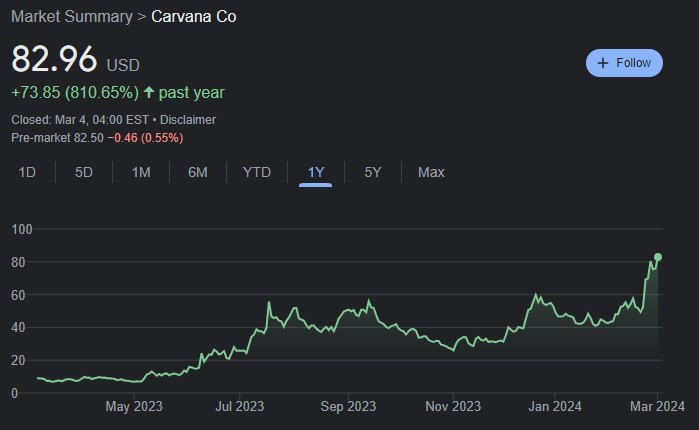The stock market can be harsh and unforgiving, yet it also presents opportunities for remarkable turnarounds. Carvana (NYSE: CVNA) is a prime example. Despite Carvana teetering on the edge of bankruptcy, CVNA stock has staged an incredible comeback, soaring by over 800% in the past year.

The company currently carries a significant debt load of $6.3 billion and trades at a 110x price-to-earnings (P/E) ratio. Simultaneously, default rates on car loans have reached levels reminiscent of the financial crisis 2008, and the inventory of used cars is experiencing a steep rise.
So, how did Carvana manage an unlikely comeback?
From the brink of bankruptcy for Carvana
In 2022, Carvana witnessed a decline in car sales compared to the previous year, marking the first occurrence in nine years. Concurrently, CVNA experienced escalating losses as the used car market underwent a downturn.
Carvana’s losses surged to $806 million, equivalent to $7.61 per class A share of stock, as opposed to $89 million reported in the final quarter of 2021. The company incurred losses amounting to $1.6 billion for the entire fiscal year, starkly contrasting the $135 million loss recorded in 2021.

To an 800% surge in CVNA stock
Carvana’s Q4 fell short of analyst expectations, with a $1 per share loss and a 15% drop in revenue. Despite this, it saw an increase in gross profit per unit. However, it still managed a full-year profit due to a strong Q3.
Looking ahead to 2024, Carvana anticipates growth in retail unit sales and adjusted EBITDA, with Q1 adjusted EBITDA projected to exceed $100 million.
Carvana also expects a slight uptick in retail unit sales in Q1, marking a return to growth after a decline since Q2 of the previous year.
Analyst Brad Erickson from RBC Capital Markets described the fourth-quarter report from the online used-vehicle retailer as “fundamentally mixed” in a note to clients on February 23. He highlighted Carvana’s shortfall in units sold, revenue, and EBITDA (earnings before interest, taxes, depreciation, and amortization) for Q4. Additionally, Erickson expressed concerns that the projected unit sales for 2024 are likely to disappoint.
Short squeeze contributed to CVNA stock gains
While the company did highlight some positive aspects in its recent quarterly reports, the remarkable surge in its stock value is primarily credited to a short squeeze.
With CVNA being heavily shorted (66.54% of its float), retail investors found it relatively easy to exert pressure on short sellers.
Buy stocks now with eToro – trusted and advanced investment platform
Disclaimer: The content on this site should not be considered investment advice. Investing is speculative. When investing, your capital is at risk.








